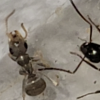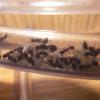Greetings, users of this website that I apparently only use once a century to ask stupid questions! I'll make some ant journals eventually, I swear. My larger colony of Formica subsericea has been approaching (or has already reached; dunno exactly how many workers they have since there's always some hiding in this groove they've made in their water cotton) the mark of 25 workers, and they are, in my opinion, outgrowing the "single test tube in a food storage container with some sand in it" setup I'm currently housing them in. I could just add another test tube and make an official "tub and tubes" residence, but I was thinking about getting a true nest for them once they reached 25. I've been browsing the Ant Keeping Depot for options, and, well... quite frankly, having no prior experience with this, I've no clue what would be best suited for them. I don't know what kind of nesting material they'd like, for one, but mainly, I'm concerned about size; it's one thing looking at the dimensions of a nest on a webpage, or even measure out a space on my shelf to accommodate said dimensions, but it's another thing entirely seeing it in person, y'know? I could order a product originating from halfway across the planet, only for it to arrive and find out that I miscalculated and it's too big or even too small. So, in part due to my perpetual anxiety that something will go wrong if I do something for the first time without assistance, I'd like to ask for help.
Don't worry about price too much! I have plenty of excess savings to spend at the present time. Also, sorry if there's already a topic along these lines.




















